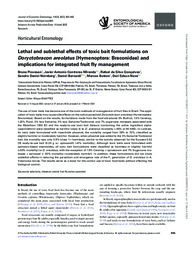Lethal and sublethal effects of toxic bait formulations on Doryctobracon areolatus (Hymenoptera: Braconidae) and implications for integrated fruit fly management.
Lethal and sublethal effects of toxic bait formulations on Doryctobracon areolatus (Hymenoptera: Braconidae) and implications for integrated fruit fly management.
Author(s): PIOVESAN, B.; CONTRERAS MIRANDA, J. A.; GONÇALVES, R. da S.; NÖRNBERG, S. D.; BERNARDI, D.; BOTTON, M.; NAVA, D. E.
Summary: The use of toxic baits has become one of the main methods of management of fruit flies in Brazil. The application of toxic baits may cause side effects on the native parasitoid Doryctobracon areolatus (Hymenoptera: Braconidae). Based on the results, formulations made from the food attractants 3% Biofruit, 1.5% Ceratrap, 1.25% Flyral, 3% Isca Samaritá, 3% Isca Samaritá Tradicional, and 7% sugarcane molasses associated with the Malathion 1000 EC and the ready-to-use toxic bait Gelsura (containing the active ingredient alphacypermethrin) were classified as harmful (class 4) to D. areolatus (mortality > 85% at 96 HAE). In contrast, for toxic baits formulated with insecticide phosmet, the mortality ranged from 38% to 72%, classified as slightly harmful or moderately harmful. However, when phosmet was added to the 3% Samaritá Tradicional bait, the mortality was only 3.9% (class 1—harmless), similar to the toxicity observed for the Success 0.02 CB ready-to-use bait (0.24 g a.i. spinosad/l) (<5% mortality). Although toxic baits were formulated with spinosyn-based insecticides, all toxic bait formulations were classified as harmless or slightly harmful (<50% mortality) to D. areolatus, with the exception of 1.5% Ceratrap + spinetoram and 7% Sugarcane molasses + spinosad (? 60% mortality—moderately harmful). In addition, these formulations did not show sublethal effects in reducing the parasitism and emergence rate of the F1 generation of D. areolatus in A. fraterculus larvae. The results serve as a basis for the correct use of toxic food baits without affecting the biological control.
Publication year: 2023
Types of publication: Journal article
Unit: Embrapa Grape & Wine
Keywords: Doryctobracon areolatus, Mosca das Frutas
Observation
Some of Embrapa's publications are published as ePub files. To read them, use or download one of the following free software options to your computer or mobile device. Android: Google Play Books; IOS: iBooks; Windows and Linux: Calibre.
Access other publications
Access the Agricultural Research Database (BDPA) to consult Embrapa's full library collection and records.
Visit Embrapa Bookstore to purchase books and other publications sold by Embrapa.

